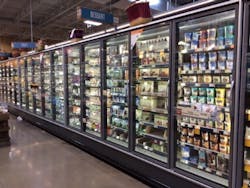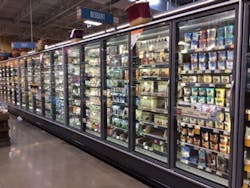Refrigerated display units are subject to a variety of load stresses. Monthly and yearly checkups, and proper diagnostic procedures help to keep cases cool. It’s really quite elementary.
Load management, as it relates to refrigerated display cases, requires some detective work. And for every ‘case’ you solve, the greater your diagnostic skill becomes. There are generally four categories of loads that can affect the operation of refrigerated display cases:
1. Transmission loads.
This is the amount of heat that flows through walls, the ceiling, and floors. This load is determined by the temperature difference between any two surfaces, the thickness and type of insulation being used, and the surface area.
Whenever a case door is opened, the surrounding ambient air enters the refrigerated space, which results in a sizable source of heat gain. This air must then be
3. Product loads.
These consist of three components: the specific heat above or below freezing; the latent heat; and the respiration heat of a given product. In almost all situations, a product display case will never be designed to remove latent energy from a product. All products that would be stocked in a freezer display should already be frozen, and a small amount of sensible energy may have to be removed. Respiration heat is heat that is present in fresh fruits and vegetables, and the amount of heat energy released in a display case will be minimal. In storage and walk-in coolers, however, this heat energy must be figured.
4. Miscellaneous loads.
These loads are caused by lights, motors, and people and the following usage related factors:
- dirty condensor coils
- improper defrost frequencies,
- length of defrost (which can changeseasonally)
- improper display case stocking levels (falling below minimum allows for warm air to enter the case, overstocking can obstruct the air curtain that forms the insulating barrier between the ambient and the case air)
- obstructed grilles and/or registers that provide proper airflow across the evaporator coil
- worn door gaskets or misaligned doors
- defective hinges
- unbalanced doors that will not close on their own, thus increasing the air change load.
EXAMPLES OF CASE DISCHARGE AIR TEMPERATURES:
Open/non-frozen display case
Meat...............................28FDairy/deli........................32F
Processed produce........36F
Unprocessed produce....45F
Maintenance to the Rescue
Improper heat loads can be minimized or eliminated by following a monthly and annual preventive maintenance schedule. That includes cleaning the condensor coils on a monthly basis to allow for maximum heat transfer, and performing the following monthly checks:
- display case air curtains, gilles and registers, for dirt
- cases, for obstructed air flows, and for minimum and maximum load levels
- door gaskets, for leaks and tears
- doors, for defective hinges, closers, and alignment
- refrigerant charge (if refrigerant needs to be added, check the system for leaks)
- defrost time clocks, validate correct operation.
On a yearly basis, perform a through checkup of the entire system, including the items mentioned above, paying special attention to compressors and motors, logging amperage readings, megging-out compressor motor windings, checking crankcase oil levels, and logging superheat and subcooling levels. Additional checks may need to be performed, depending on the type of equipment.
Diagnosing Improper Heat Loads
The following steps are recommended steps or observations for taking data to determine whether a display case is working as intended:
- A stainless steel thermometer accurate to 2F should be used for measuring case temperature. Locate the stem of the thermometer in the air stream at the discharge opening, not more than 1-in. from the surface.
- Determine that the case is providing refrigeration, and that it has been running for at least one hour since the time of the last defrost.
- Record the temperature reading only after the case has stabilized.
- Check the feel and appearance of the product to determine an undesirable condition.
If the product is above normal temperature, check the following:
- Has the case been loaded with warm product?
- Are store display signs blocking the airflow?
- Has the case been overloaded?
- Are the return and discharge air ducts blocked?
- Do you notice any drafts in the conditioned space outside of the case?
- Are the evaporator coils iced up?
- Is the temperature of the store more than 75F or at 55% relative humidity?
Possible Component Failure
If a regularly scheduled maintenance program such as the one described above is in place, improper heat loads should be eliminated, which would lead your diagnosis down the path of a defective component.Check the obvious culprits: are all evaporator and condensor motors running, and is the compressor operating? If yes, determine the state at which our evaporator and condensor coils are operating. Are they in a “flooded,” a “normal,” or a “starved” condition? The only way of determining this is by recording the operating superheat and subcooling.
Evaporator Coil Superheat
Low superheat (5F or lower) = flooded condition.
Normal superheat (8 to 12F) = normal condition.
High superheat (15F or higher) = starved condition.
Condensor Coil Subcooling
Low subcooling (5F or lower) = starved condition.
Normal subcooling (8 - 12F) = normal condition.
High subcooling (15F or higher) = flooded condition.
Interpreting Superheat, Subcooling Readings
If subcooling and superheat fall within the normal range, the problem is not mechanical in nature, except for the possibility of some intermittent valve sticking or moisture freezing and thawing at an orifice.If a leak has developed that is large enough to have caused the system to be undercharged, you will see a low-to normal suction pressure, low liquid line pressure, low subcooling, and normal-to-high superheat, depending upon the severity of the leak or undercharge.
If a low load condition has occurred (frozen evaporator), you will see a low suction pressure, normal-to-low superheat, low liquid line pressure, and low subcooling.
If the liquid line has been restricted, you will see low suction pressure, high superheat, high liquid line pressure, and high subcooling.
If an expansion valve has become restricted, or if its power element has lost its charge, you will see low suction pressure, high superheat, high liquid line pressure, and high subcooling.
All of the values listed are approximate. For exact values, consult with the display case manufacturer.
This type of equipment can be quite complex, with the addition of electronic expansion valves, multiplex compressor racks serving multiple cases, heat reclaim coils, an array of condensor coils, water cooled, air-cooled, or evaporative type cooling. Therefore, when working on this type of equipment, always refer to the manufacturer’s specifications and recommendations.
Bruce Schaefer is a refrigeration and boiler specialist for HVACR distributor Johnstone Supply, and is based in St. Peters, MO. He can be reached at 314/447-0603.
About the Author
Bruce Schaefer
refrigeration and boiler specialist
Bruce Schaefer is a refrigeration and boiler specialist for HVACR distributor Johnstone Supply, and is based in St. Peters, MO. He can be reached at 314/447-0603.

